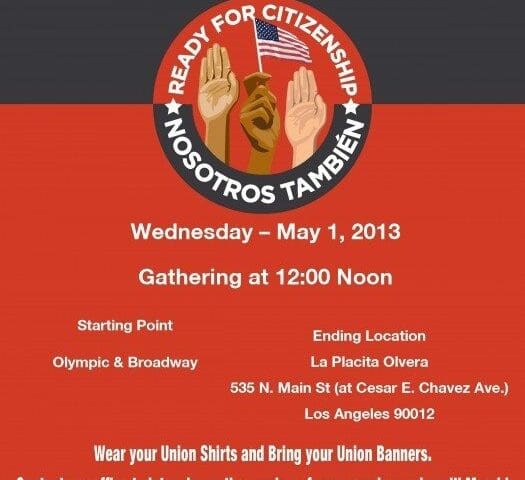

» Read more about: All Out May Day for Immigration Reform! »
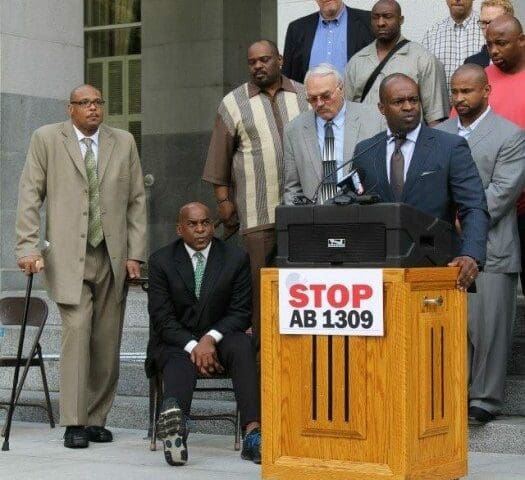
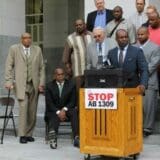
There is no question that the game of football is dangerous. National Football League players get injured on the job – so many that an “injury report” section is ubiquitous in our sports pages. In fact, a study run by the National Institute for Occupational Safety and Health (NIOSH) found that the risk of death associated with neurodegenerative disorders is about three times higher among NFL players than the rest of the population.
NFL athletes are not merely players, they are also employees.
Their employers are now trying to take away their collectively bargained right to workers’ compensation benefits in California. It is not right, and it sets a dangerous precedent.
Assembly Bill 1309 singles out one group of workers, professional athletes, and treats them differently than other employees by denying them the right to file for California Workers’ Compensation benefits.
AB 1309 is an attempt by the insurance companies and professional teams to shift the cost of care for injured players from the companies to state agencies like Medi-Cal and federal agencies like Medicare.
» Read more about: Assembly Bill to Kill Athletes’ Workers’ Comp Claims »
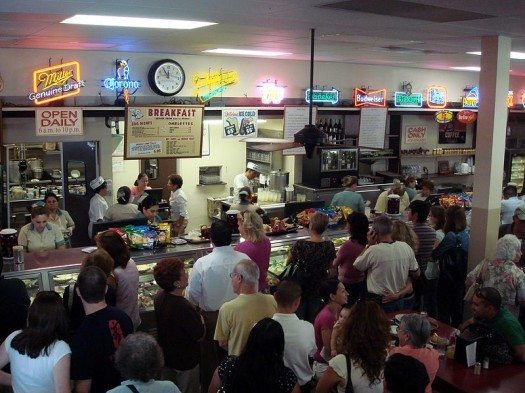

(Jack Lavitch and Henry Lee are two West L.A. retirees who are also part-time, second-hand car buyers. They were lunching at Philippe the Original sandwich diner near central Chinatown when asked about the coming mayor’s race.)
Jack Lavitch
“First and foremost, the next mayor should fix up our city streets. There are potholes everywhere and they are a danger to us all. This would be something everyone could easily see — it would make a huge difference for everyone. That’s something [the mayor] could actually accomplish. It wouldn’t cost that much and it would make us all feel better about the whole city.”
“Oh yes,” he adds, biting into his sandwich. “He could get everyone free French dips like this one every Friday. I am joking.”
Jack is skeptical about official claims stating the city is nearing bankruptcy. “Maybe they actually are but they haven’t convinced me or the public.
» Read more about: L.A. Mayor’s Race: The View from Philippe’s »


(Note from Warehouse Workers United: Please take action now — workers like Javier, whose blog appears below, should not be fired with impunity. We will deliver this petition to Walmart today, April 29, 1 p.m., PDT.)
One month ago my son Alex was born. Yesterday I was fired from my job as a forklift driver at a warehouse where we move 100 percent Walmart merchandise.
I am outspoken. I defend my coworkers. I alert management about broken and unsafe equipment. I teach my coworkers about their rights, like what minimum wage is and what they should do when they are injured on the job.
I have been a target of management for a while. They watch everything I do, but it’s not my nature to be silent or scared. I know when I am right. Last year I went on strike to protest the retaliation my coworkers experienced when they spoke to the media and the public about the dirty water (if we had any water at all) that we were given to drink,
» Read more about: Help Reinstate Walmart Contract Worker Javier Rodriguez »


 We come together as Americans when confronting common disasters and common threats, such as occurred in Boston, but we continue to split apart economically.
We come together as Americans when confronting common disasters and common threats, such as occurred in Boston, but we continue to split apart economically.
Anyone who wants to understand the dis-uniting of America needs to see how dramatically we’re segregating geographically by income and wealth. Today I’m giving a Town Hall talk in Fresno, in the center of California’s Central Valley, where the official unemployment rate is 15.4 percent and median family earns under $40,000. The so-called “recovery” is barely in evidence.
As the crow flies Fresno is not that far from California’s high-tech enclaves of Google, Intel, Facebook, and Apple, or from the entertainment capital of Hollywood, but they might as well be different worlds.
Being wealthy in modern America means you don’t come across anyone who isn’t, and being poor and lower-middle class means you’re surrounded by others who are just as hard up.


 We all know that sequestration and the automatic $85 billion in federal cuts “across the board” for discretionary spending jeopardize our very delicate recovery from the Great Recession. Though slow, fragile and incremental, the recovery is real, thanks in part to an unsung legislative action — that now is in danger of being undermined by congressional inaction.
We all know that sequestration and the automatic $85 billion in federal cuts “across the board” for discretionary spending jeopardize our very delicate recovery from the Great Recession. Though slow, fragile and incremental, the recovery is real, thanks in part to an unsung legislative action — that now is in danger of being undermined by congressional inaction.
In 1998, Congress passed the Workforce Investment Act (WIA), which greatly improved unemployed people’s lives. The WIA focused on providing employment and training services for youth and adults, preparing them for jobs in industries using a model that encouraged self-sufficiency and widespread access to resource centers and training. The goal was to help people learn the skills for life-long career advancement.
What made WIA special was that that it proactively engaged with business, education and labor (as the drivers of local economies) to guide the direction of workforce development programs in a way that would specifically address geographical needs.
» Read more about: It’s Time to Reinvest in Workforce Development »
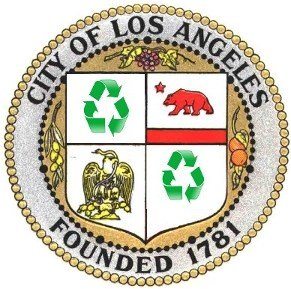

 Progress, like beauty, is in the eye of the beholder. Witness the reaction to today’s landmark L.A. City Council vote, approving the implementation plan for a far-reaching overhaul of the city’s multi-family and commercial waste and recycling system.
Progress, like beauty, is in the eye of the beholder. Witness the reaction to today’s landmark L.A. City Council vote, approving the implementation plan for a far-reaching overhaul of the city’s multi-family and commercial waste and recycling system.
The plan, which passed 10-3, puts L.A. squarely in the forefront of a growing national movement to transform the way cities deal with waste. For the first time companies will have to meet a set of environmental and labor standards in order to operate. Under this exclusive franchise system, the city will be divided into 11 zones, with companies competing to be the sole operator within each zone.
Among those celebrating the City Council’s decision were environmentalists, waste workers and small business owners, who as part of the Don’t Waste LA coalition have driven the campaign to reform L.A.’s waste and recycling industry. Less enthusiastic were certain industry lobbyists and big business advocates,


(Art Sweatman is a City of Los Angeles tree surgeon. His post is a response to Los Angeles Times columnist Steve Lopez’s April 24 article, “Time for public employee unions to pick up the tab.” The post first appeared on SEIU Local 721’s site and is republished here with permission.)
Dear Steve:
I sat down with you a couple of years ago and discussed the impact that “givebacks” would have on our SEIU 721 members who work for the City of Los Angeles.
You seemed to care then, and city workers eventually agreed to help L.A. save money. One year later we also agreed to contribute more towards our pension benefits, so we could keep our spouses on our benefits after we retire.
Your commentary is short-sighted. You acknowledge but ignore the fact that the politicians keep lying about the city’s deficit.
» Read more about: Union Worker to Steve Lopez: We’ve Picked Up the Tab! »


Two local Thursday events will mark preparations for the annual Workers’ Memorial Day that will be observed nationally on Sunday. Today’s morning activities center on the unveiling of a work-in-progress mural depicting the contributions of immigrant workers and the release of the annual “Dying at Work in California” report. The survey tallies the cost of job-related deaths, injuries and illnesses and tells the stories of the 196 Los Angeles workers killed on the job last year. These stories include:
» Read more about: Workers’ Memorial Day: Not One More Death or Injury! »
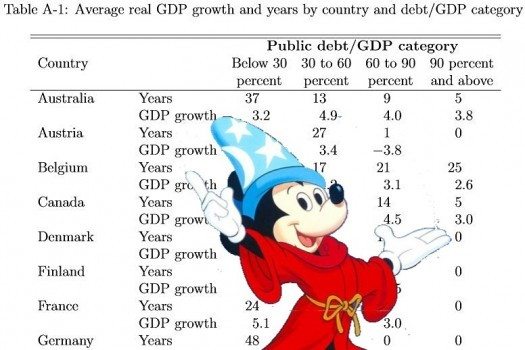
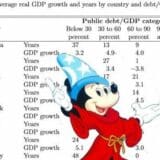
Most of us accept that the earth goes around the sun. This is impressive, since we can look up in the sky and see the sun going around the earth. We believe the opposite because we have been told about the research of astronomers over the centuries showing that what we can see with our own two eyes is wrong. Instead, we accept that the motion of the stars and planets can be much better explained by the earth going around the sun.
Suppose for a moment that astronomers and people who write on astronomy did not agree on earth or solar orbits. Imagine that a substantial group of these people, including many of the most prominent astronomers, insisted that the sun goes around the earth, as anyone can plainly see. In that case, there would likely be huge numbers of people who refused to accept that the earth goes around the sun.
» Read more about: Mickey Mouse Economics: Austerity Bible Debunked »


 Cherri Senders wasn’t always looking for the union label. Back in the late 1980s the Washington, D.C. native was writing for the L.A. Weekly, an alternative newspaper that was generous with editorial pleas for social justice but miserly when paying its own workers.
Cherri Senders wasn’t always looking for the union label. Back in the late 1980s the Washington, D.C. native was writing for the L.A. Weekly, an alternative newspaper that was generous with editorial pleas for social justice but miserly when paying its own workers.
“I saw how exploited writers were,” Senders tells Frying Pan News. “We joined the National Writers Union and were able to go from five cents a word to seven. That’s how I found out about the labor movement.”
About 15 years later a friend of Senders, who by then had started her own communications company, wanted to learn how to purchase union-made baby products, but couldn’t find a way to track down which ones bore a union label.
There had always been Buy Union lists – often out of date and pinned to the bulletin boards of union halls or,
» Read more about: Looking for the Union Label in All the Right Places »


Guilt — in the psychoanalytic tradition — is both a form of self-punishment and a key obstacle to therapeutic improvement. In The Ego and the Id, Freud wrote that the patient finds “satisfaction in the illness and refuses to give up the punishment of suffering.” In a paradoxical way, obsessive guilt becomes a masochistic attempt at an unreliable cure.
The Company You Keep, starring and directed by Robert Redford, is a film awash in guilt. Redford’s character, Jim Grant, an ex-radical still “hiding” in plain sight, feels guilt about his past and about the secrets he has to withhold from his daughter. A reporter, played by Shia LaBeouf, eventually feels guilty about the impact his bulldog reporting might have on the people he’s writing about. A tenured radical professor feels guilty about not keeping up “the struggle,” unable to inspire his students beyond a round of applause at the end of his stories.
» Read more about: The Sixties: What a Long, Strange Guilt Trip It’s Been »
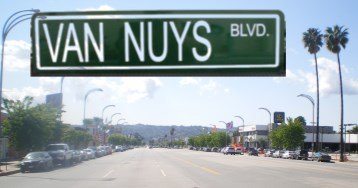

(As the May 21 mayoral runoff election approaches, Frying Pan News is asking voters what they believe the next mayor’s priorities should be — as well as what he or she should avoid doing once in office. This week reporter Marc Haefele interviews three San Fernando Valley voters near the corner of Van Nuys and Burbank boulevards; all three women are Van Nuys residents.)
Karen Rontowski
We do need a better distribution of wealth in our city. At the same time, we need more funding for both teachers and police. Of course I’d like to see more jobs, but how much can the mayor alone do to accomplish something like that? Maybe we can only work with that problem on the national level. There was a lot of flash to Antonio Villaraigosa and yet not too much substance.
» Read more about: L.A. Mayor’s Race: The View from the Valley »
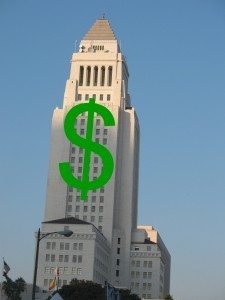

 For five years a chorus of voices has been predicting bankruptcy for Los Angeles, while often calling for deeper cuts to city employee pensions. Today, however, Mayor Antonio Villaraigosa proposed a budget for Fiscal Year 2013-2014 that includes a one-time surplus of $119 million. While some of that surplus would rely on additional pay and benefit reductions for city workers, even without such cuts the city would have a projected surplus of close to $100 million.
For five years a chorus of voices has been predicting bankruptcy for Los Angeles, while often calling for deeper cuts to city employee pensions. Today, however, Mayor Antonio Villaraigosa proposed a budget for Fiscal Year 2013-2014 that includes a one-time surplus of $119 million. While some of that surplus would rely on additional pay and benefit reductions for city workers, even without such cuts the city would have a projected surplus of close to $100 million.
“It’s better than seeing the light at the end of the tunnel – we’re almost out of the tunnel!” Matt Szabo, Mayor Villaraigosa’s deputy chief of staff, told Frying Pan News in an interview last week. Szabo discussed the city’s financial picture and said that dire financial warnings have been largely overblown.
“One of the issues that’s highly irritating is the ease with which some people have thrown around the bankruptcy term,” Szabo said.
» Read more about: Budget Shocker: L.A. Shows $119 Million Surplus »


 After several years of swimming in red ink, the city of Los Angeles is now projecting a $119 million surplus for Fiscal Year 2013-2014, according to city documents presented at a news conference today presided over by Mayor Antonio Villaraigosa. (See Page 3 of the mayor’s Budget Presentation.)
After several years of swimming in red ink, the city of Los Angeles is now projecting a $119 million surplus for Fiscal Year 2013-2014, according to city documents presented at a news conference today presided over by Mayor Antonio Villaraigosa. (See Page 3 of the mayor’s Budget Presentation.)
City Administrative Officer Miguel Santana and other officials also attended the media event at City Hall.
The surplus is dependent on the city receiving certain one-time revenues, much of them due from the state and federal governments.
Nevertheless, this disclosure dramatically rebuffs a steady stream of predictions, made by an array of officials, mayoral candidates and commentators, that L.A. faces the possibility of bankruptcy. Such predictions have invariably been accompanied by calls to reduce the pension benefits of city employees.
Later this morning Frying Pan News will post investigative reporter Gary Cohn’s analysis of what has produced the surplus – and of the motivations behind predictions of the city’s insolvency.
» Read more about: Bulletin: New L.A. Budget Shows $119 Million Surplus »
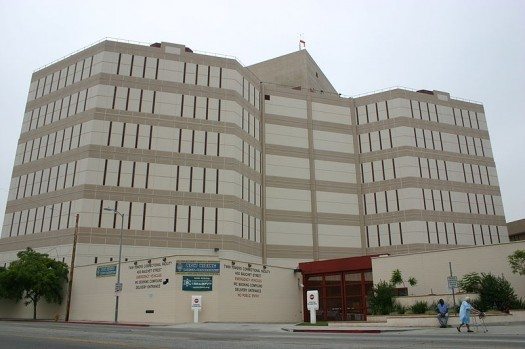

With jails straining to absorb thousands of prison inmates, jailhouse guard-on-inmate beatings grabbing headlines, and public concern rising about possible spikes in crime rates, public safety issues—especially around the massive Los Angeles County jail and probation systems—have Angelenos of all stripes scrambling for answers.
The just-concluded three-part, “Smart Justice: Rethinking Public Safety in California” discussion at the University of Southern California, capped off with a fourth session at the Pat Brown Institute, brought together key leaders—from top L.A. County public safety managers to heads of organizations charged with monitoring those systems—to identify often well-known problems, but also to propose potential solutions, cures that generally involve replacing “punishment” with “rehabilitation” in corrections thinking.
A Combustible Environment
“Los Angeles County has the largest probation department in the nation, the largest sheriff’s department, and the third largest police force in the L.A. Police Department,” said Alex Johnson from the Office of County Supervisor Mark Ridley-Thomas.
» Read more about: Facing Los Angeles’ Incarceration Dilemma »


Weeks after a political stalemate set in motion $85 billion in federal spending cuts for fiscal year 2013, sequestration has shifted from a political debate in the halls of Congress to a looming reality in neighborhood streets – especially in some of the poorest areas of the country.
In Georgia, the drop in federal dollars is taking an 11 percent bite out of extended unemployment benefits that more than 61,000 Georgians depend on for food, utilities and housing, according to the Rome News-Tribune.
In Mississippi, 2,300 children under the age of three will likely lose the care and early education they receive in federally-supported Early Head Start programs.
And in Texas’s Rio Grande Valley, sequester will mean cuts in legal aid services and housing vouchers for low-income families and reductions in job-search services for the unemployed.
Many community organizations that serve low-income families are already feeling the money pinch.
» Read more about: Sequester Taking a Toll on America’s Needy »


 The reason President Obama’s proposal to cut Social Security benefits is tragic is that it is simply not necessary. His plan is to use a different method to compute how much benefits are raised to offset inflation. But Social Security will add very little to federal spending over the next 30 to 40 years. As a proportion of national income (GDP), It will rise from five percent to six percent. At the same time, retirees are set to get much less money from their pensions because so many were forced to depend on 401(k)s and defined contribution plans rather than traditional pensions with defined benefits.
The reason President Obama’s proposal to cut Social Security benefits is tragic is that it is simply not necessary. His plan is to use a different method to compute how much benefits are raised to offset inflation. But Social Security will add very little to federal spending over the next 30 to 40 years. As a proportion of national income (GDP), It will rise from five percent to six percent. At the same time, retirees are set to get much less money from their pensions because so many were forced to depend on 401(k)s and defined contribution plans rather than traditional pensions with defined benefits.
But a new report from Goldman Sachs economists puts the Obama decision in an even harsher light. The federal deficit is coming down rapidly on its own. In a piece entitled, “The Rapidly Shrinking Federal Deficit,” Goldman notes that the deficit averaged 4.5 percent of GDP in the first calendar quarter,
» Read more about: The U.S. Deficit Is Down — So Why Cut Social Security? »

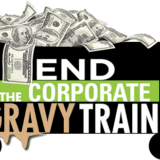
 Hundreds of workers descended on the Capitol yesterday as part of the California Labor Federation’s legislative conference lobby day with a simple message for both Democrats and Republicans in office: “End the Corporate Gravy Train.” They were referring to the state’s wasteful enterprise zone program, which takes money away from schools, infrastructure and other valuable services to line the pockets of corporate CEOs at Walmart and other large, profitable corporations.
Hundreds of workers descended on the Capitol yesterday as part of the California Labor Federation’s legislative conference lobby day with a simple message for both Democrats and Republicans in office: “End the Corporate Gravy Train.” They were referring to the state’s wasteful enterprise zone program, which takes money away from schools, infrastructure and other valuable services to line the pockets of corporate CEOs at Walmart and other large, profitable corporations.
At a lunchtime rally, workers, labor leaders and elected officials railed against this massive giveaway and urged support for SB 434, a reform bill authored by State Sen. Jerry Hill. The event coincided with the launch of a new website, www.EndTheCorporateGravyTrain.com, which details the wasteful program and exposes some of the massive companies that are riding the gravy train.
California Labor Federation Executive Secretary-Treasurer Art Pulaski:
“Taxpayers are sending $700 million per year straight into the pockets of corporate executives without seeing good jobs created in return.
» Read more about: Capitol Rally: Derail This Corporate Gravy Train! »


Pastor Nestor Gerente welcomed the overflow audience of nearly 350 Long Beach activists at last week’s People’s State of the City gathering and said, “This is a great crowd. Where are you on Sunday mornings?”
The 23 organizations sponsoring the event, under the tent of the Long Beach Coalition for Good Jobs and a Healthy Community, are still buoyant from victory in last November’s election. That’s when Measure N, the Hotel Workers’ Minimum Wage Law, passed by 64 percent of the voters, raised wages to $13 an hour for some of the lowest paid hotel workers in L.A. County. The stunning triumph was made possible by a grassroots mobilization and door-to-door campaign of union and community members.
Grace United Methodist Church’s beautiful sanctuary was filled with people of every racial and ethnic background now living in California’s seventh largest city. Long Beach has nearly half a million residents —
» Read more about: Long Beach Activists Look Beyond Measure N »